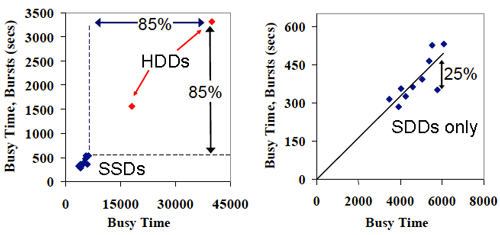Crucial m4 And Intel SSD 320: The Other SSD Competitors
Final Words
Where do all the drives fall in relation to one another? If you are looking the best-performing SATA 6Gb/s drive, the Vertex 3s don't top every chart, but they finish strongly enough to consistently show well in our list. In this context, Crucial's m4 turns out to be a close contender. The key point is going to be price. We expect the 240 GB Vertex 3 to sell around $500, or $2.08 per gigabyte. If Crucial can introduce the m4 at under $2/GB, we'd consider that a best buy.
Intel's SSD 510 is impressive in that its sequential transfers are clearly strong; however, it wouldn't be a good drive to drop into a Web server or database machine. Moreover, it bears a fairly hefty price tag relative to its competition. The 120 GB model costs $284. Compare this to a 128 GB Crucial RealSSD C300 that runs less than $250.
If you're still on a system limited by SATA 3Gb/s, there are many more options. Intel's SSD 320 rectifies some of the shortcomings of the X25-M. But if your just a general consumer, there isn't any reason to overlook the second-gen X25-M. Intel's newest SSD achieves better sequential write and random write performance thanks to its larger cache. However, the move to 25 nm comes at the cost of random read performance. This is a situation where the X25-M continues to outperform its successor. This mirrors what we saw with OCZ's Vertex 2, though there is a smaller performance delta between Intel's two generations. Price is where Intel really makes the SSD 320 attractive. The 120 GB SSD 320 only costs $209, which is just below $1.75 per gigabyte.
Practically, shifting from 34 nm NAND to 25 nm flash imposes reduced endurance. The 34 nm MLC was previously rated at 5 000 PE cycles. The majority of 25 nm MLC is now rated at 3 000 PE cycles. The problem is that you can't rely on PE cycles alone to determine the life of a drive. Other factors, such as the write algorithm, garbage collection, and wear-leveling all factor into the total life you get out of an SSD. Intel is making a point to improve the way its SSD 320 addresses concerns over reliability in a world now more acutely concerned about the ramifications of flash manufactured using smaller lithography.
As a result, we are finding it harder to call clear winners here, especially since write durability isn't something you can test in a weekend. Intel is banking on other bullet points to catch your eye. For example, the company is trying to make the point that its brand can be equated to high drive reliability, and features like power protection are intended to put prospective buyers' minds at ease. But Intel isn't the only player on the block. For as much as we scour and agonize every benchmark, the performance differences within a group of SSDs is becoming much harder to differentiate. Even among different sites, you'll find that a single setting can mean the difference between one drive topping a chart and another falling to the bottom.
There is a world of difference between a SSD and a HDD. This has always been evident. If you already own a SSD, it's hard to turn back. Unless you need (or want) a high-performance SSD, you'll find that most drives tend to fall within a tight performance spectrum. If SSD prices are a major limiting factor, don't let benchmarks deter you from pulling the trigger. You don't have to have the best SSD to get great performance relative to a HDD. For example, the first-gen SandForce drives continue to perform very well. Intel is leading the charge toward higher capacities, more pointed reliability-oriented optimizations, and lower prices. So even though its Postville refresh isn't going to go down in history as the same game-changer its first X25-M was, it's still arguably one of the most exciting introductions, if only for its impact on the affordability of solid-state storage.
Get Tom's Hardware's best news and in-depth reviews, straight to your inbox.
Current page: Final Words
Prev Page Benchmark Results: PCMark Vantage Storage Test-
Could you expand on the Full Disk Encryption capabilities of the Intel 320?Reply
If you can actually use hardware FDE on that drive (rather than just secure erase), that's a winner for me. -
bto Why does the Intel 510 250GB appear to have two scores in crystalmark? (469.4 and 259.7) on the top benchmark on page: "Benchmark Results: CrystalDiskMark Streaming Performance" the specs are identical for both.Reply -
poppasmurf Great lil tidbit, wonder what the difference will be between other SSD's with different interface connections other than physical appearance and the interface connection. More on the lines of pro's and con's between the SSD interface connections I'm referring to the OCZ PCI-e drives vs. SATA 6GB just a thought to stir up the hoop la of ssd's :PReply -
JohnnyLucky I am beginning to wonder if we haven't reached the point where the human eye and brain are finding it harder to differentiate performance among ssd's. Some mainstream benchmarks seem to suggest that. Some of the benchmarks in this review seem to indicate the same. There are some very tight groupings.Reply -
henryvalz At the speed points that SSDs are functioning, I'm beginning to think that durability and reliability might be the best basis for decision. I would also really like to see some boot times from Windows 7, or loading time for games.Reply -
kev_stev Does anyone know when the vertex 3 and M4 are going to actually be available? I have heard rumors that the vertex 3 will be released "any day now" since mid march...Reply -
iamtheking123 I'll go SSD in my next build, probably in a year and a half. Right now I'm satisfied with Raid 0-ed 1TB Caviar Blacks.Reply

